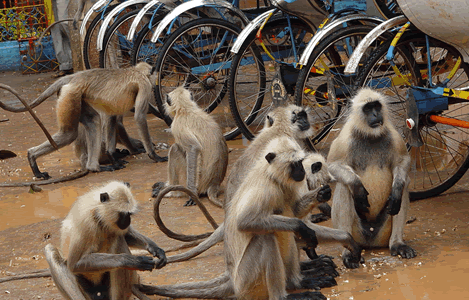|
That
gorgeous patch of earth

Photograph
by Preeti Verma Lal
She is dark
and oh boy! how wholly gregarious she can be. She is such a great mimic that when
she performs men drool. Some call her audacious; others put the pest epaulette
on her shiny skin. But this scion of the starling family is a great artiste and
very pricey. That's the hill mynah for you - the black bird adorned with orange
and yellow wattles and very conceited about its repertoire of 13 calls. This impressionist
also happens to be the state bird of Chattisgarh.
She
is dark and oh boy! how wholly gregarious she can be. She is such a great mimic
that when she performs men drool. Some call her audacious; others put the pest
epaulette on her shiny skin. But this scion of the starling family is a great
artiste and very pricey.
That's the hill mynah for you - the black bird adorned
with orange and yellow wattles and very conceited about its repertoire of 13 calls.
This impressionist also happens to be the state bird of Chattisgarh. The
Sparrow could not be wrong about the mynah, could he? So when noted ornithologist
Dr Salim Ali talks of the dialects of hill mynah (gracula religiosa) believe him.
You walk a few kilometers and the warbles and the wails of the gregarious mynah
you heard a while ago would change considerably in tenor. It is like walking from
one village to another and getting lost in the sudden showbiz of another language.
And if you want to see hill mynah, go to Chattisgarh,
south Chattisgarh, to be precise. The black birds have made the dense forest of
Kanger Valley their home. You don't need to strain your ears to hear their whistles
and the wails, they are literally piped through the forest. Of the four species
of the hill mynahs found in India, the Bastar mynah is considered the smartest
mimic of the human voice. If the hill mynah is Chattisgarh's
pricey pin-up girl, the macho Asiatic wild buffalo is its state animal. An endangered
species, the wild buffalo can be found only in the Indrawati/Kutru National Park
in the Indrawati valley of Bastar. Efforts are being made to protect the species
from extinction. Project Wild Buffalo has been launched in Udanti and Pamer sanctuaries.
Soon the wild buffaloes would be wearing radio collars to help wildlife experts
track their habits and prepare a better protection strategy. In
its 10 sanctuaries and four national parks, the forest play host to several other
animal species - lion, cheetah, spotted deer, sambhar, barking deer, bear, to
pick some of them. Of course, the crowd depends on the relevant habitat but the
forests of Chattisgarh are still one of the best in the country. The
state has nearly 14 percent of the country's forest cover and roughly 60,928 sq.
kms. of its total area have a forest canopy accounting for almost 50 percent of
the state's territory. Of the total forest cover, nearly one-thirds are covered
with sal trees. The sal trees not only add the green cover and maintain the ecological
balance, they also contribute more than 40 percent of the total annual forest
revenue and provide livelihood to thousands of people through the 10,000 industrial
units that depend on forest for their raw material. There
are 22 varied forest types found in the state, but from the management point of
view they can be categorized into sal, teak, miscellaneous and bamboo forest.
Sal, said to be the only evergreen forest tree in the country, stretches with
gay abandon in Barnawapara and Sitanadi sanctuaries covering 244 and 533 sq.kms.,
respectively. Of these, Sitanadi is said to have the best sal forest in the state,
just as the Godavri basin is reputed for its moist teak. When
forest is discussed in Chattisgarh, the conversation often skews to its symbiotic
relationship with the tribals. Not only do the tribals depend on the forest for
their daily sustenance they also find their deities and their doctors there. Chattisgarh
is known for its rich variety of medicinal plants - ambda, anjan, amla, harra,
kurlu, kusum - which are used for ailments ranging from simple fever to more complicated
ones like cancer, leprosy, diabetes, even abortions. When
in Chattisgarh, think William Blake and his tigers burning bright in the forests
of the night. Or just listen to the hill mynah and dream under a sal tree.
Published in Discover India magazine, September
2004. | 
